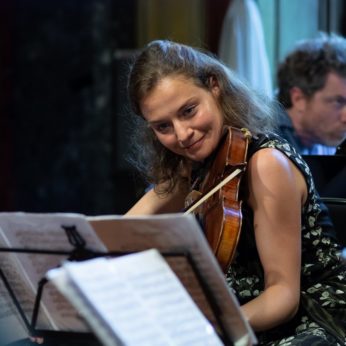Composer: Gabriel Fauré (b. 1845 - d. 1924)
Performance date: 08/07/2018
Venue: Bantry Library
Composition Year: 1886
Duration: 00:36:36
Recording Engineer: Tom Norton, RTÉ
Instrumentation: 2vn, 2va, 2vc
Instrumentation Category:Piano Quartet/Piano Quintet
Instrumentation Other: vn, va, vc pf
Artists:
Elina Vähäla -
[violin]
Dana Zemtsov -
[viola]
Andreas Brantelid -
[cello]
Cédric Pescia -
[piano]

The slow
movement of my second Quartet is one of the few places where I realise that,
without really meaning to, I recalled a peal of bells we used to hear of an
evening, drifting over the Montgauzy from a village called Cadirac whenever the
wind blew from the West. Their sound gives rise to a vague reverie which, like
all vague reveries, is not translatable into words.
It is poignant that in his Second Piano Quartet Fauré
unintentionally included this echo of his happy childhood, completing it as he
did in the year following the death of his father. Although he had lived far
from his father they had corresponded regularly and the loss was a great blow
to him.
Fauré had been married by then for some three years to
Marie Fremiet. She was not his first choice; indeed legend has it that her name
had been drawn from a hat in the years following his heartbreak at a broken
engagement. His passion for the woman who rejected him was not matched by that
for his wife, and it seems she had little for him either. It was a time,
perhaps, for the young composer to come to terms with the reality of a life
falling short of his hopes and his joy at the birth of his first son in 1883
was tempered by periods of depression.
The opening theme is a stormy, drawn out melody of
sustained notes in the unison strings set against pounding tremolandos on the
piano. The development moves between wistfulness and acquiescence gradually
becoming more restless as it leads us back to the stormy opening of the
recapitulation culminating eventually in an exhausted coda.
The brief but gripping second movement, although
marked scherzo, is a nightmarish perpetuum mobile, its rhythms oddly suggestive of the endlessly revolving wheels of
trains on which Fauré was, reluctantly, spending so much time. This turbulent
journey propels us towards the still beauty of the third movement,
The opening bell figure of the third movement
accompanies a moving lament in the viola, which is passed to the violin before
eventually drawing all three strings together to create a sublimely expressive
second subject. In the development a version of the bell pattern is taken up by
the strings and it is the piano that explores the opening melody, gradually
suffusing it with sunlight. When it is taken up again, altered, by the violin
it is filled with a new optimism only to be returned to its original spare form
for the recapitulation. A long coda strives for peaceful rest, finding it in
the closing bars.
This peace is
immediately undermined by the dark magnificence of the Allegro molto that brings us back to the troubled mood of the
Scherzo. Here it is the rich, burnished colours of cello and viola in unison
which drives the melody forward to an increasingly tempestuous development.
When the exposition material returns there is little sense of promise for a
positive resolution until its steady build towards a carefree coda lands us in
the unexpected brightness of the major key.
Copyright © 2025 West Cork Music. All rights reserved.
Designed and developed by Matrix Internet